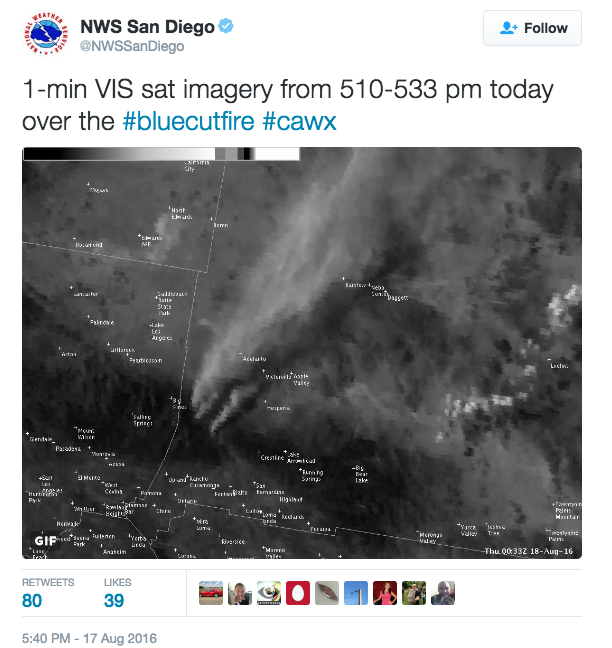
[ Archive ]

 |
CIMSS-NOAA Weekly Report [ Archive ] |
 |
ASPB AND CIMSS WEEKLY HIGHLIGHTS FOR THE WEEK ENDING AUGUST 19, 2016
IN THE PRESS:
ITEMS FOR THE ADMINISTRATOR:
ITEMS FOR THE ASSISTANT ADMINISTRATOR:
ITEMS FOR THE OFFICE DIRECTOR, STAR:
Pierce Wins the 2016 NOAA Administrator’s and Technology Transfer Award: Robert Pierce from the Advanced Satellite Product Branch is a recipient of the 2016 Administrator’s and Technology Transfer Award for providing robust, real-time, simulated data of the next generation geostationary satellite imagers, reducing risk in post-launch operations. Brad and other award recipients will be honored at a November ceremony at the NOAA Auditorium in Silver Spring, Maryland. (J. Key, E/RA2, 608-263-2605, jkey@ssec.wisc.edu)
Paper Published on Arctic Clouds in Reanalyses: A paper "Assessment of Arctic Cloud Cover Anomalies in Atmospheric Reanalysis Products Using Satellite Data" by Yinghui Liu (CIMSS) and Jeff Key (NOAA/NESDIS) has been published in the journal of Climate. This paper examines the performance of five atmospheric reanalysis products—ERA-Interim, MERRA, MERRA-2, NCEP R1, and NCEP R2—in depicting monthly mean Arctic cloud amount anomalies against MODIS and CALIPSO, and is available at http://dx.doi.org/10.1175/JCLI-D-15-0861.1. (Y. Liu, CIMSS, 608-265-8620)
AMS Satellite Meteorology Conference held in Madison, WI: The American Meteorology Society (AMS) joint 21st Satellite Meteorology, Oceanography and Climatology Conference and 20th Conference on Air-Sea Interaction conferences were held the week of August 15 in Madison, WI. Members of the Space Science and Engineering Center (SSEC), the Cooperative Institute for Meteorological Satellite Studies (CIMSS), and the STAR Advanced Satellite Products Branch (ASPB) played many roles associated with being local hosts, including: conference chairs, program chairs and members, session chairs, poster chair, student judges, along with poster and oral presentations. SSEC sponsored an exhibit room featuring RealEarth (https://realearth.ssec.wisc.edu/), McIDAS-V (http://www.ssec.wisc.edu/mcidas/software/v/), and Satellite Information Familiarization Tool (SIFT). Two tours of SSEC were provided during the week providing access to rooftop and data center. (T. Schmit, E/RA2, 608-263-0291 and W. Feltz, CIMSS, 608-265-6283)
National Academies of Science Workshop on Volcanic Eruptions: By invitation, Mike Pavolonis (NOAA/NESDIS/STAR) participated in a National Academies of Sciences, Engineering, and Medicine workshop on “Improving Understanding of Volcanic Eruptions” August 17-19, 2016 in Washington D.C. The overarching goal of the workshop was to help direct and focus future volcano science for informing volcano monitoring and early warning efforts. Working groups, composed of international experts from government agencies and academia, were utilized to assess various aspects of volcanism. M. Pavolonis served as the rapporteur of the “Satellite Data Needs” working group. The final report of this study, which was funded by the National Science Foundation, National Aeronautics and Space Administration, U.S. Geological Survey, and the National Academies of Science, will be available early in 2017. NOAA has an operational responsibility to monitor volcanic ash emissions over a very large region. Improved understanding of volcanic eruptions, including ash dispersal, will lead to improvements in NOAA’s operational forecasts of airborne volcanic ash, through application of new knowledge and tools in operations. In addition, NOAA’s satellites will play a significant role in improving volcano science and monitoring. (M. Pavolonis, E/RA2, 608-263-9597, Mike.Pavolonis@noaa.gov)
ITEMS FOR THE DIVISION CHIEF, CoRP:
GOES-14 Rapid Scan Data: Fog, Fire, and Convection: Working with a number of operational and research groups, the center points for the GOES-14 1-min rapid scan imagery were determined each day. These groups included: Cooperative Institute for Meteorological Satellite Studies (CIMSS), Cooperative Institute for Research in the Atmosphere (CIRA), Weather Prediction Center (WPC), Ocean Prediction Center (OPC), Storm Prediction Center (SPC), several Weather Forecast Offices (WFO)s and the Aviation Weather Testbed (AWT). To better prepare for the meso-scale sectors on the Advanced Baseline Imager (ABI) on GOES-R, the phenomena monitored this week included: fog, fires and smoke, and many cases of convection, both over the Midwest and East Coast. These data were used operational by a number of users; the rapid scan data was acquired at the Space Science and Engineering Center (SSEC) data center, disseminated to a number of users and saved. A web page was updated with center locations, animations, blogs, tweets and other information: http://cimss.ssec.wisc.edu/goes/srsor2016/GOES-14_SRSOR.html. (T. Schmit, E/RA2, 608-263-0291, tim.j.schmit@noaa.gov; S. Bachmeier, CIMSS, 608-263-3958; S. Lindstrom, CIMSS)
 (Click image to enlarge)
(Click image to enlarge)
Figure caption: Screen capture of a tweet from the NWS San Diego regarding the GOES-14 1-min data of the California Bluecut fire.
VISITORS:
NEXT WEEK:
LOOKING AHEAD:
| Archived Weeklies Page | Submit a report item |